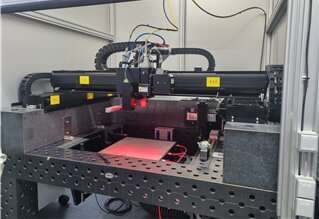
Fuel cells used for vessels and airplanes are becoming increasingly lighter to improve efficiency, and this is leading to a decline in the thickness of bipolar plate. Now, a laser machining technology for thin bipolar plate, which can help to enhance the production efficiency and quality of fuel cells, has been developed through international R&D innovative collaboration project.
Through international joint research between Korea and Germany, a team consisting of the Korea Institute of Machinery and Materials (President Sang-jin Park, KIMM), an institute under the jurisdiction of the Ministry of Science and ICT, K-Lab, a Korean small and medium-sized enterprise, and Germany's Fraunhofer Gesellschaft and BBW Lasertechnik, developed a new 2D on-the-fly composite equipment by applying a scanner that allows for laser welding and cutting of materials for bipolar plates for fuel cells with thickness of 0.075mm.
Principal Researcher Su-jin Lee of KIMM Department of Industrial Laser Technology and the team focused their attention on the demands from fuel cell manufacturers that require the welding of large-scale thin plates of various forms as well as high-quality cutting at the same time. The work is published in the journal Metals.
The joint research team used the conventional technology where the stage and the scanner move simultaneously, and succeeded in developing a Top-Lamp composite processing machine capable of welding and cutting large areas (400mm x 400mm or larger) in various forms by cross-coupling the cutting gas output nozzle to the stage.